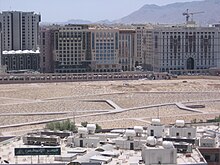
Back إزالة مواقع التراث الإسلامي في مكة والمدينة Arabic Səudiyyə Ərəbistanında erkən islam abidələrinin dağıdılması Azerbaijani সৌদি আরবে ইসলামের প্রাথমিক যুগের ঐতিহ্যবাহী স্থানসমূহের ধ্বংসযজ্ঞ Bengali/Bangla Zerstörung des islamischen Kulturerbes in Saudi-Arabien German Destrucción de patrimonio islámico en Arabia Saudita Spanish تخریب میراث تاریخی صدر اسلامی در عربستان سعودی Persian Destruction de sites liés à l'Islam précoce French Penghancuran situs warisan Islam awal di Arab Saudi ID Distruzione di siti associati al primo islam in Arabia Saudita Italian സൗദി അറേബ്യയിലെ ഇസ്ലാമിക പൈതൃകങ്ങളുടെ നശീകരണം Malayalam

The destruction of heritage sites associated with early Islam is an ongoing phenomenon that has occurred mainly in the Hejaz region of western Saudi Arabia, particularly around the two holiest cities of Islam, Mecca and Medina.[1] The demolition has focused on mosques, burial sites, homes and historical locations associated with the Islamic prophet Muhammad, his companions, and many of the founding personalities of early Islamic history by the Saudi government.[1][2] In Saudi Arabia, many of the demolitions have officially been part of the continued expansion of the Masjid al-Haram at Mecca and the Prophet's Mosque in Medina and their auxiliary service facilities in order to accommodate the ever-increasing number of Muslims performing the pilgrimage (hajj).[3]
- ^ a b "Wahhābī (Islamic movement)". Encyclopædia Britannica. Edinburgh: Encyclopædia Britannica, Inc. 9 June 2020. Archived from the original on 26 June 2020. Retrieved 8 September 2020.
Because Wahhābism prohibits the veneration of shrines, tombs, and sacred objects, many sites associated with the early history of Islam, such as the homes and graves of companions of Muhammad, were demolished under Saudi rule. Preservationists have estimated that as many as 95 percent of the historic sites around Mecca and Medina have been razed.
- ^ "Medina: Saudis take a bulldozer to Islam's history". The Independent. 26 October 2012. Archived from the original on 6 September 2017. Retrieved 14 November 2014.
- ^ "'Cultural genocide of Islamic heritage' in Saudi Arabia riles Sunni Sufis". The Times of India. 11 April 2013. Archived from the original on 11 April 2013.
© MMXXIII Rich X Search. We shall prevail. All rights reserved. Rich X Search